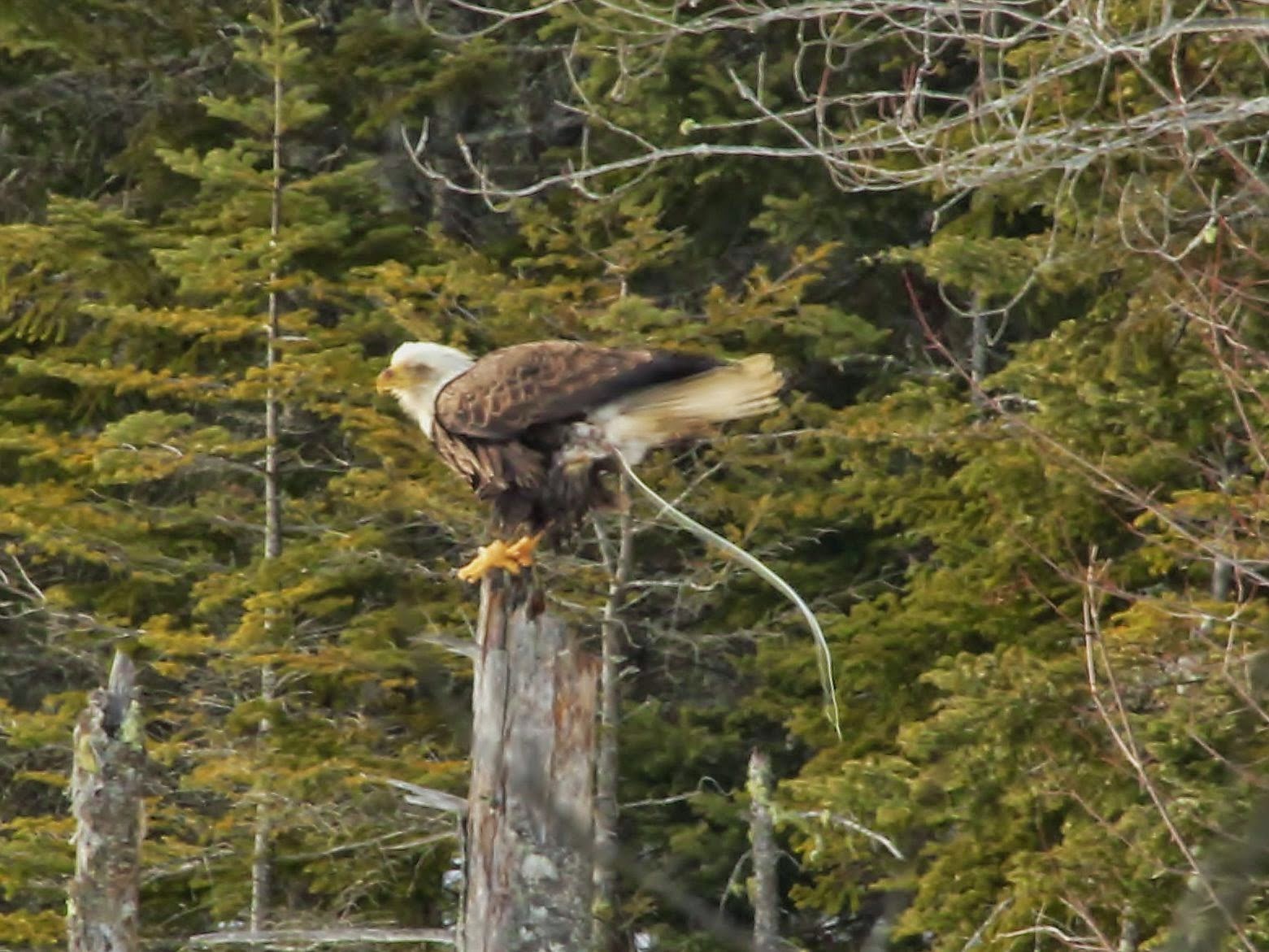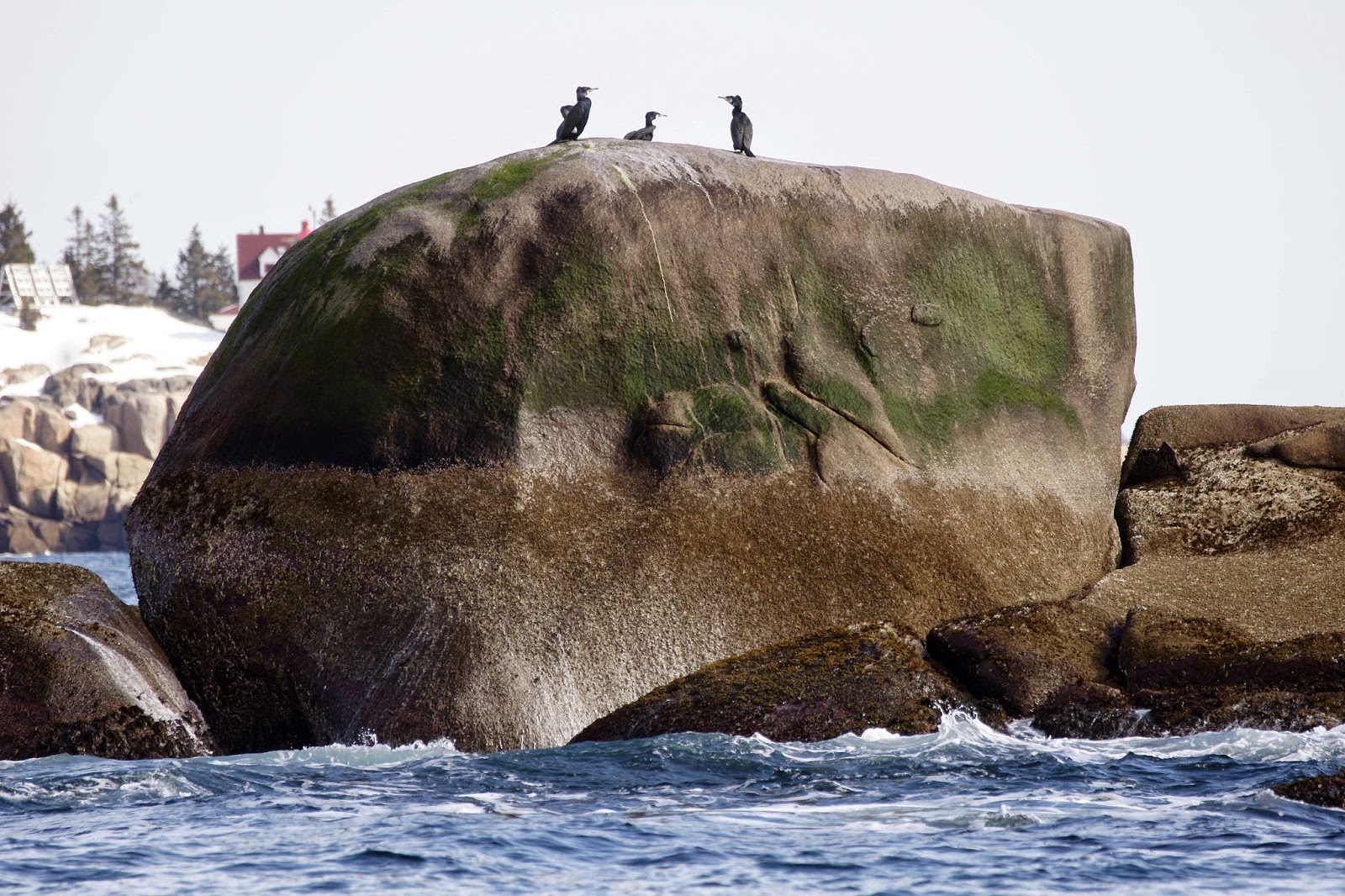 |
| needs no words Awesome shot Sally! Thanks for sharing! photo by Sally Conway |
Welcome to the vinalhaven sightings report – March 23rd, 2015
MCHT and VLT
Wondering what the snow fleas have been up to
Highlights – otter, owls and mink. Red tail
hawk, snow fleas!!!! , boat ride, when seal bay freezes over!

Upcoming Events – VLT/MCHT Woodcock Walk – Saturday
April 4th, 7pm at Lane’s Island. Be there or be somewhere else!
 |
| roger covered in snow |
VLT/MCHT Basin Clean-up – Sunday April 12th, 9am at Skoog to
carpool. We’ll be
cleaning up near the Basin bridge for a few hours, come on out and help!
 |
| seal bay |
Business – contact us – vinalhavensightings@gmail.com – where else can you share your
nature sightings and photos? Facebook? That’s soooooo 2014. I mean, feel free
to get Facebooked and all that…but then send them over to the VSR! We’d love to
see what you have seen.
Tiit trick –
click on the photos to make them jumbo sized.
 |
| seal bay has these ice formation too! |
 |
| ice caves at seal bay |
 |
| how deer made it to seal bay! |
Grackles for a
day – the “true harbinger of late-winter”, a handful of Common Grackles, was spotted between up the sands (3/11). Not reported since.
These days - Spring singers, drummers and callers- black-capped
chickadee, cardinals, red-breasted nuthatch, song sparrow, downy and hairy woodpeckers,
Great-horned Owl
 |
| it's snow flea season! |
Snow Fleas –
With all the wondrous snow this winter, it is no surprise that so many people
have approached me with concerns about the wildlife on Vinalhaven. Even
raccoons have brought out sympathy from some, but there is one species that
literally (not really) has been on everyone’s minds – Snow Fleas!
Figuring the answers to my questions
were as follows – (1) “fine”, (2) “not at all”, (3) “probably
not”, (4) “what?” and (5) “idiot” – soon after I lost whatever “concerns” I
had. But then (3/13) came along and all my vanished “concerns” vanished even
more. None more concerns. (“The answer is none. None more black” – Nigel
Tufnel).
Fox Rocks area
– (3/13) a half mile hike on a nice warm day, resulted in a half mile back
track back out following my old footsteps. And each and every one of my “less
than an hour old” snowshoe prints having snow fleas in them, some filled more
than others of course. I had never seen such a stretch of snow fleas in my
life! Bursting onto the scene with such intensity and magnitude it was as if
the snow fleas had been waiting for this moment for all their lives. Which
might be true – I don’t know how long they live actually.
Hey – now’s a good time to drop some
basic Snow Flea knowledge down –
Gwen person “Wired”
“Technically, springtails aren’t
proper insects at all, since their body has a different design than the
standard insect plan. Their taxonomic
name is Collembola, and while they are in the group Hexapoda (which contains
the Insecta), they are not classified as insects. Their eyes are not proper compound eyes, and
their abdomen has fewer segments and some special extra appendages that insects
don’t have. Springtails also keep molting (shedding their exoskeleton) through
their lives; the world record is 52 moults. That’s way more than any insect or
spider, and kind of amazing for such a tiny animal.”
“Springtails get their name from their jumping apparatus -– they don’t
use their legs to jump like fleas and grasshoppers, but have a special little
appendage that flicks them up and around. This furcula is like a spring; when
it’s released, it flings the springtail up over 100 times its body length. Alas
for the springtail, they can’t control where they go -– but it’s still
effective for predator avoidance.”
 |
| the sun has not set on snow fleas |
“The mechanics of their jump are pretty fascinating — snow fleas’
exoskeletons power their flips. It contains a rubber-like protein called
resilin, where a lot of the potential energy for the jump is stored, but blood
pressure and muscles also are involved.”
“Snow flea courtship involves a lot of head banging. Females are usually
larger than males, and it's thought that she assesses a male's suitability by
making him push her around. Literally”
Eating habits
– from “Fairfax County Public Schools” website- thank you public schools!
 “Snow
Fleas, and other springtails, live in soil, leaf litter, mosses, fungi, and
along shores of ponds. Sometimes they can be found on the surface of ponds.
Since they are so light, they can walk on the surface without sinking.
“Snow
Fleas, and other springtails, live in soil, leaf litter, mosses, fungi, and
along shores of ponds. Sometimes they can be found on the surface of ponds.
Since they are so light, they can walk on the surface without sinking.
They eat old dead plant matter, bacteria, fungi, algae, pollen, roundworms,
rotifers, and sap. Roundworms and rotifers are tiny microscopic animals.”
 |
| raccoons do not eat snow fleas - unless by accident |
 |
| been nice to see the raccoon highways once again |
And finally back to Gwen Person from
Wired - “Here’s what some People may not
realize it, but Snow Fleas, and all springtails, are very important. They are
decomposers, and help break down old dead plant matter and other items in the
soil. After the springtails are done with them, plants can pull the nutrients
back from the soil and use them to grow. Then, people and other animals can use
the plants. Springtails are an important part of nature's cycle”.
 |
| dead saw-whet |
 |
| feathers and owl spraint |
(3/19) Lane’s – on a quick snowshoe on Lane’s I found some Saw-whet Owl feathers that had been
ripped out of a Saw-whet owl (makes sense) presumably by a Great Horned, but maybe a
Long-eared could have done it I guess. Either way it’s one less Saw-whet to
worry about....
 |
| owl scat looks like this they don't lift their tails, so the scat comes straight down |
 |
| part of a frozen and thawed pellet |
 |
| Brimstone in snow |
Boat Ride – (3/19) on the Skua –Capt. John Drury was kind enough to take me for a spin around the Whites (islands not Heather and Adam) and over to Brimstone.
 |
| great cormorants on the rocks |
 |
| looking good and ready to go |
 |
| Harlequins on the move |
 |
| purple sandpipers photo by John Drury |

And their “student definition” - a periodic state during which the female of
most mammals is willing to mate with the male and is capable of becoming
pregnant
Since there has been snow – which has
been for a while now – we have been posting about what a great year it has been
for Mink out here, and now the year is apparently getting even greater! I was
tracking a pair of mink out on Lane’s
(3/17) who appeared (from their tracks) to be getting along from the way their
trails were crossing and interacting (interacting trails? Whatever). Then I came
upon this scene.
From the looks of it one of the mink –
assumed to be the female – let out a
spraintload of red liquid –assumed to be blood – in mid run. The mink didn’t
break stride as the gush flowed for a few bounds, eventually bleeding into some
of its own tracks.
 Now, back in March 2005 – the 15th
I believe – I found a similar scene out on lane’s – lots of mink trails and
rolls with spots of blood sprinkled throughout. This year’s female looks to be
even more “good to go” than the 2005 female as this was no sprinkling of blood,
but a splashing.
Now, back in March 2005 – the 15th
I believe – I found a similar scene out on lane’s – lots of mink trails and
rolls with spots of blood sprinkled throughout. This year’s female looks to be
even more “good to go” than the 2005 female as this was no sprinkling of blood,
but a splashing.  |
| can you hear the "sploosh" sound of estrus being released |
I did a something search on “mink
estrus photos” was pleased to see the VSR as one of the first links, but the
photos in general should little estrus and more mink trails. I did not do a something
search on “what does mink estrus sound like” but I would have to assume (lot of
assuming here) that it sounds a little like “sploosh”. I should have sniffed it, but I didn’t want to be tricked
into pursuing the female – I am a male whether other males accept me in their
clan or not.
Anyway – what a cool scene to find. I
bet they are “shagging like mink” out there as we speak!
Otters – and no winter VSR would be complete without some otter stuff.
Crockett River Road – Adam White and Jamus Drury spotted some otters slides where freshwater
flows into the cove – very cool!
Norton’s Point
– Oscar looks to have gotten over his grumpiness at getting his photo taken,
and tuned up at this one latrine 3 times in a week. Rolling and tumbling, Oscar
was marking up a storm!
 |
| Oscar rolling |
 |
| heading up stream |
Basin to Vinal Cove – one of my favorite lessons I have learned on Vinalhaven is that otters
run across the island. The first cross island trail that I observed was the “Basin-Long Pond-thru the woods – Folly pond
shoreline- to Vinal Cove” otter runs from 2008. I hadn’t crossed paths with
this route being used pretty much since, but an otter made that run on the 18th,
and I was fortunate enough to be in the area on the 19th for some
fun tracking!
 |
| crossing long pond |
The otter came out of the Basin by
the Long Pond outflow – the cross island runs I have come across have all have
freshwater drainages as the starting and ending places. It (he most likely)
worked its way up the stream – under ice and snow – until it got to the pond. There
it bounded and slid its way along the entire length of the pond, and then
booked it thru the woods!
Up, up, up – why would an otter head
up and over the highest point around instead of going along the lower (though
longer) and somewhat easier to traverse valley system that could also take him
to Folly Pond? Maybe less time out of the water means less time for predators
to snag – but really – who is getting an otter out here? I doubt even a Great
Horned would be silly enough to go after them. Survival instinct. Yeah sure.
Or maybe he wanted to get the longest slide he could get? That was what I was going with – unfortunately he took such a zig zaggy route down there was hardly room to belly slide much. He actually was sliding just as much on the flat frozen lake!
 |
| heading down the hill - about the biggest slides in the woods |
So I have come to the conclusion that it is simply the way he goes. The otter in 2008 was possibly another otter – they don’t live too too long - but it took the same route. And that’s why we love otters – they are creatures of habit and that makes them easy!













